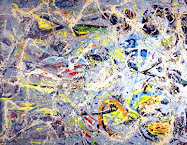
There is a pretty hefty backlash that has accompanied the abstract movement. It's just a crock and a hoax - an elaborate promotional "smoke and mirrors" show, if you ask the detractors. What good is art that is
about nothing?
The latest installment from the naysayers is the
Teri Horton Five Dollar Pollock story. Her story is well covered in the news media, and it's a knee-slapper. Did the retired lady truck driver inadvertantly buy a forgotten Jackson Pollock painting? She found the big canvas at a thrift store, and bought it for her friend as a joke for 5 bucks. An art professor from the local college gave her the clue that it might be a Jackson Pollock, and her retort is classic: "Who the #@*^! is Jackson Pollock?"
So, here is our dear Teri, holding onto this (virtually worthless to her) painting that maybe could fetch up to $140,000,000 if she can just find the right sucker buyer for it. I am doubled over in laughter watching clips of this lady and a host of arts professionals tearing their hair out trying to make up establish a provenance for it.
Was there a fingerprint on the Five Dollar Pollock that corresponds to known Jackson Pollock fingerprints? Evidence from his Long Island studio, and from a JP in the Tate museum apparently match. But, the hard-headed and harder-hearted arts experts disagree. Fingerprints don't mean anything to museum curators or art appraisers that have seen the painting.
This woman is trailer trash, basically, to the snobby snobs of the art world, and the ghost of JP himself could appear to them and say: "It's mine!" and they still wouldn't buy it from the likes of Teri Horton. Take it as an article of faith - you can't trade with the high brows if you don't smell like money already. That's the message of the story Horton is putting forth, anyway.
If a Pollock really could be purchased for $5, then what is the real intrinsic value of a big canvas covered with drips? If he were any good, why couldn't he just paint a figure, a faerie or a piece of fruit, like any other normal artist?
It all comes down to provenance, in my humble opinion. No signature on the work? Then, if the artist Jackson Pollock painted it, and didn't sign it, then he was devaluing it, himself. Then, he failed to destroy it, which is the accepted norm for artists. It seems that our Teri Horton was offered 9 Million dollars for the piece, but refused it as too little. Bad move.
Artists today have powerful tools to establish a paper trail for their work: signature (DUH!), jpeg, date of creation, list of showings, commentary from first and third party sources, receipt of sale with value established, names of owners, etc. All these things are data that helps to tag that artwork down through history.
Teri's Five Dollar Pollock is a byproduct of the Antiques Roadshow era, where any schmuck can fall off a turnip wagon and come up smelling like a rose. Rags to riches, as it were. Don't be angry at the art world, Teri. Brush up on your pitch!
The bigger lesson is the commentary on modern art that this episode reveals. The rank and file don't like the art, don't care for the artists that much and really dislike the highbrow art world that surrounds this whole mess. But, I have found out that there is a similar current in society that doesn't like any art, abstract or real. The artist today, and the army of other people who make their livings from art, have a ways to go before they have the exalted place in society and civilization that they picture for themselves. Maybe one start may be to reach out to the Teri Hortons of the world, somehow. A little proof of value wouldn't hurt the artist any.
I liked what this commenter had to say regarding the Five Dollar Pollock and Horton's problems with it:
"Ultimately, it does not matter if the painting is a Pollock or not. The value of it is determined by what someone is willing to pay for it. There is no intrinsic value of any 'Art' piece. There is no MSRP in the art world. She was offered 2 million dollars for it, so that is what it is currently worth (if that offer even still stands). If she rejects that offer and /or it is rescinded, and there is no other offer, the painting is worth 5 dollars. plain (sic) and simple. This is economics 101. 'Art' is no exception."
Posted by pmfaricy on Sun, May 6, 2007 9:17 PM ET
Another Blogger's opinion:
http://www.bookofjoe.com/2006/11/what_teri_horto.html
















































